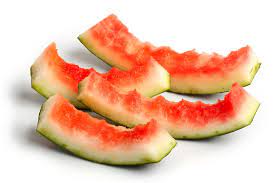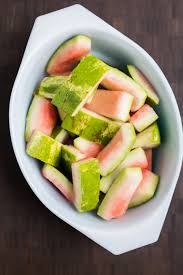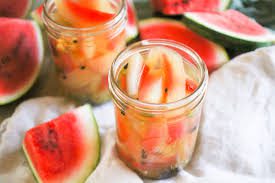Watermelon rind refers to the tough, outer green layer of the watermelon fruit that is typically discarded when consuming the juicy, red flesh. While the flesh of the watermelon is the most commonly consumed part, the rind is also edible and can be used in various culinary preparations.
The watermelon rind has a firm and crisp texture, with a slightly bitter and less sweet taste compared to the flesh. It is composed of a combination of water and fiber, making it low in calories and a good source of dietary fiber.
In certain cuisines, watermelon rind is utilized to reduce food waste and add unique flavors and textures to dishes. It is often pickled, boiled, stir-fried, or added to soups and stews. Pickled watermelon rind, in particular, is a popular delicacy in many cultures, offering a tangy and slightly sweet flavor.
When using watermelon rind in recipes, it is important to remove the tough outer skin and the softer, white part underneath, as they can be less palatable. The remaining firm, pale green part of the rind is what is typically used in cooking.
Aside from its culinary applications, watermelon rind is also believed to have certain health benefits. It is a good source of citrulline, an amino acid that may have potential health effects, including improved blood circulation and heart health. Additionally, the rind contains various vitamins and minerals, such as vitamin C and potassium.
Though, watermelon rind is a versatile ingredient that can be used creatively in the kitchen and provides a potential nutritional boost. It offers a distinct taste and texture that adds variety to culinary preparations while reducing food waste.
Economic Importance, Uses, and By-Products of Watermelon Rind

Watermelon rind, which is the firm, outer layer of the watermelon fruit, often discarded after consuming the juicy flesh, holds various economic importance and can be utilized in several ways. Here are some of the economic uses and benefits of watermelon rind:
1. Food Consumption: Watermelon rind is edible and can be consumed in various forms. It is commonly used in pickling, salads, stir-fries, and preserves. In many countries, watermelon rind-based dishes are a part of the local cuisine. For example, in the southern United States, pickled watermelon rind is a popular delicacy.
2. Nutritional Value: Watermelon rind contains a range of nutrients, including vitamins A, C, and B6, as well as potassium and citrulline. These nutrients contribute to its potential health benefits, such as supporting heart health, improving digestion, and providing hydration.
3. Culinary Applications: Watermelon rind can be used in various culinary applications, including smoothies, juices, and sorbets. It can be blended or juiced to create refreshing and nutritious beverages. Watermelon rind can also be cooked and used as a vegetable in dishes like stir-fries or curries.
4. Animal Feed: Watermelon rind can serve as a nutritious and low-cost feed option for livestock. It can be used as a supplementary feed for cattle, sheep, goats, and pigs. Farmers often utilize watermelon rind as a feed source during seasons when other forage options are scarce.
5. Natural Remedies: Watermelon rind has been used in traditional medicine for its potential health benefits. It is believed to possess diuretic properties and may help alleviate urinary tract infections and kidney stones. Additionally, watermelon rind poultices or extracts are sometimes used topically to soothe skin irritations or treat burns.
6. Industrial Applications: Watermelon rind contains a high percentage of cellulose, which can be extracted and used in various industrial processes. Cellulose from watermelon rind can be utilized for manufacturing paper, textiles, and biodegradable packaging materials. It can also be used in the production of biofuels.
7. Composting and Fertilizer: Watermelon rind can be composted, contributing to the creation of nutrient-rich soil. Its high water content and organic matter make it an excellent addition to compost piles. Furthermore, watermelon rind can be processed into organic fertilizers, providing essential nutrients to plants.
8. Craft and Art Projects: Watermelon rind’s unique texture and color make it suitable for various craft and art projects. It can be carved, painted, or used in decorative arrangements. Some artisans create intricate sculptures or use watermelon rind as a natural dye for fabrics.
9. Cosmetics and Skincare: Watermelon rind contains antioxidants and vitamins that are beneficial for the skin. Extracts or juices from watermelon rind are sometimes used in cosmetic products, such as face masks, toners, and creams. These products may help hydrate and rejuvenate the skin.
10. Waste Reduction and Sustainability: Utilizing watermelon rind helps reduce food waste and promotes sustainability. Instead of discarding the rind, its various uses ensure that a significant portion of the watermelon is utilized, reducing the environmental impact associated with waste disposal.
11. Revenue Generation: Watermelon rind can be a source of additional income for farmers or entrepreneurs. For instance, selling pickled watermelon rind, watermelon rind-based products, or composted rind as organic fertilizer can generate revenue and contribute to the local economy.
12. Traditional Crafts and Artisanal Products: In some cultures, watermelon rind is transformed into traditional crafts and artisanal products. For example, in countries like China and Thailand, watermelon rind is skillfully carved into intricate patterns or used in the creation of decorative items, such as lanterns or bowls.
Read Also : Economic Importance, Uses, and By-Products of Watermelon Tendrils
13. Culinary Preserves and Jams: Watermelon rind can be preserved through canning or fermenting processes, resulting in products like jams, jellies, or chutneys. These preserves offer a unique flavor and can be commercially produced, providing opportunities for small-scale food businesses.
14. Animal Enrichment: Watermelon rind can be used as an enrichment item for animals in zoos or sanctuaries. Animals like elephants, giraffes, and primates enjoy the taste and texture of watermelon rind, making it a cost-effective and engaging enrichment option.
15. Organic Pest Control: Watermelon rind contains certain compounds that act as natural insect repellents. It can be utilized in organic farming or gardening to deter pests and reduce the need for chemical pesticides, promoting environmentally friendly practices.
16. Juice and Beverage Industry: Watermelon rind can be processed to extract its juice, which can be used as an ingredient in the beverage industry. Watermelon rind juice can be used as a base for fruit juices, smoothies, or blended drinks, providing a unique flavor profile.
17. Food Additives and Ingredients: Extracts or powders derived from watermelon rind can be used as natural food additives or ingredients. These can enhance the flavor, color, or nutritional content of various food products, such as sauces, desserts, or baked goods.
18. Pharmaceutical Applications: Watermelon rind contains bioactive compounds that have potential pharmaceutical applications. Research is being conducted to explore the medicinal properties of watermelon rind extracts, including its antioxidant, anti-inflammatory, and anticancer properties.
19. Biogas Production: Watermelon rind, along with other organic waste materials, can be used in anaerobic digestion systems to produce biogas. Biogas is a renewable energy source that can be used for cooking, heating, or generating electricity.
20. Tourism and Agritourism: Watermelon rind-based products, such as pickles or preserves, can attract tourists and contribute to agritourism activities. This can create opportunities for farmers and rural communities to showcase their local produce and generate additional income through direct sales or tourism-related services.
21. Research and Development: Watermelon rind serves as a valuable resource for research and development purposes. Scientists and researchers can study its composition, nutritional content, or potential applications in various industries, leading to innovations and advancements.
22. Export and Trade: Watermelon rind products, such as pickles or preserves, can be exported to other countries, contributing to international trade and opening up new market opportunities. This can benefit local economies and foster economic growth.
It’s important to note that the economic uses and benefits of watermelon rind can vary depending on regional preferences, cultural practices, and market demand. However, the versatility of watermelon rind as a valuable resource with multiple applications demonstrates its potential economic significance.
The Products and By-products That Can Be Derived From Watermelon Rind
Watermelon rind, the firm outer layer of the watermelon fruit, is often discarded after consuming the juicy flesh. However, it can be utilized to create a variety of useful products and by-products through different processes. Here are some examples:
1. Watermelon Rind Pickles: Watermelon rind can be transformed into pickles through the pickling process. The rind is typically peeled, sliced, and soaked in a mixture of vinegar, sugar, and spices. After marinating for a period of time, the rind becomes tangy and flavorful, creating a delicious condiment or snack.

2. Watermelon Rind Preserves: Watermelon rind can also be used to make preserves or jams. The rind is cooked with sugar, lemon juice, and sometimes additional fruits or spices, until it softens and forms a thick, sweet spread. This can be enjoyed on toast, biscuits, or as a filling in pastries.
3. Watermelon Rind Juice: Watermelon rind can be juiced and used as a refreshing beverage. The rind is blended with water and strained to remove any fibers, resulting in a hydrating and nutritious drink. You can add a squeeze of lime or a hint of mint for added flavor.

4. Watermelon Rind Smoothies: Similar to juice, watermelon rind can be incorporated into smoothies. Blend the rind with other fruits, such as berries or bananas, along with yogurt or milk for a creamy and nutritious smoothie.
5. Watermelon Rind Salsa: Finely chopped watermelon rind can be combined with ingredients like tomatoes, onions, cilantro, lime juice, and spices to create a unique salsa. This salsa can be served with tortilla chips, grilled meats, or as a topping for tacos.
6. Watermelon Rind Tea: Dried watermelon rind can be used to make tea. The rind is typically sliced into thin strips, dried, and steeped in hot water. This herbal tea is known for its potential diuretic properties and may aid in digestion.
Read Also : Economic Importance, Uses, and By-Products of Watermelon Fruits
7. Watermelon Rind Face Mask: Watermelon rind can be used in skincare as a natural face mask. The rind is blended into a paste or combined with other ingredients like honey, yogurt, or oatmeal. This mask can help hydrate and rejuvenate the skin, leaving it feeling refreshed and glowing.
8. Watermelon Rind Compost: Watermelon rind can be composted to create nutrient-rich soil for gardening. Chop the rind into smaller pieces and add it to your compost bin along with other organic matter. Over time, it will decompose, enriching the soil with essential nutrients.
9. Watermelon Rind Candy: Watermelon rind can be candied to create a sweet and chewy treat. The rind is typically boiled in sugar syrup until it becomes translucent and tender. It can be enjoyed on its own or used as a topping for desserts like cakes or ice cream.
10. Watermelon Rind Chutney: Watermelon rind can be cooked down with spices, vinegar, and sugar to create a flavorful chutney. This condiment can be used as a dip, spread, or accompaniment to various dishes, adding a tangy and slightly sweet element.
11. Watermelon Rind Jelly: Watermelon rind can be transformed into jelly by cooking it with sugar, pectin, and lemon juice. The mixture is then processed and canned, resulting in a translucent and wobbly jelly that can be spread on bread or used as a glaze for pastries.
12. Watermelon Rind Fritters: Watermelon rind can be grated and mixed with flour, spices, and eggs to make fritters. The mixture is then shaped into patties and fried until golden brown. These fritters can be served as a snack, side dish, or even as a burger patty substitute.
13. Watermelon Rind Vinegar: Watermelon rind can be fermented to produce vinegar. The rind is chopped and soaked in water, sugar, and a starter culture like yeast or vinegar mother. Over time, the mixture ferments and turns into vinegar, which can be used for culinary purposes or as a natural cleaning agent.
14. Watermelon Rind Animal Feed: Watermelon rind, particularly after the sweet flesh has been removed, can be used as animal feed. Farmers and livestock owners can chop the rind into smaller pieces and feed it to animals such as pigs or cows, providing them with a source of hydration and additional nutrients.
15. Watermelon Rind Natural Dye: Watermelon rind can be used as a natural dye for fabrics and fibers. Boiling the rind extracts its color, which can be used to dye clothing, yarn, or even create artwork.
These examples of products showcase the versatility of watermelon rind and how it can be repurposed to create various products and by-products, ranging from culinary delights to eco-friendly alternatives.
Read Also : The Role of Waste Collection Companies in a Sustainable Future
